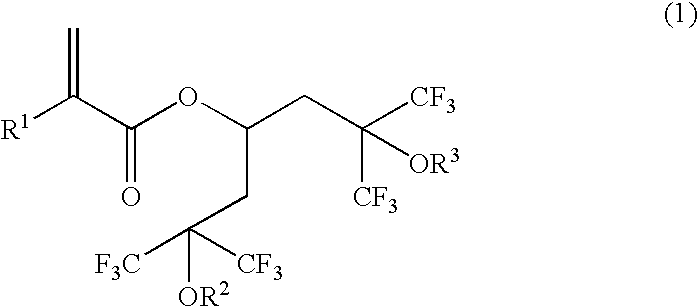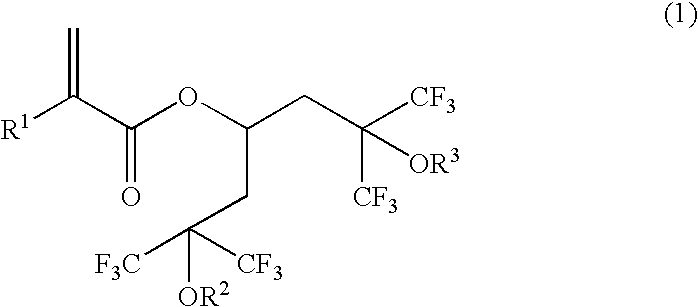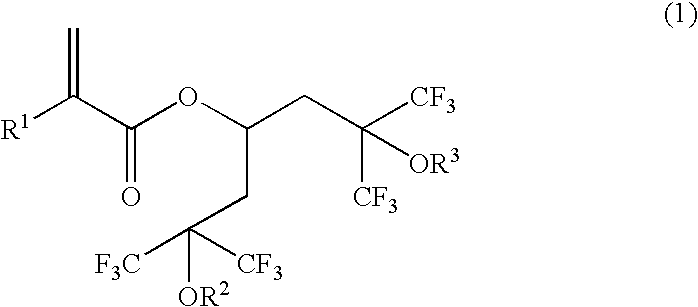Novel polymerizable acrylate compound containing hexafluorocarbinol group and polymer made therefrom
- Summary
- Abstract
- Description
- Claims
- Application Information
AI Technical Summary
Benefits of technology
Problems solved by technology
Method used
Image
Examples
synthesis example 1
Synthesis of an Alcohol Represented by the Following Formula (7)
[0032]
[0033] Sodium borohydride (6.30 g, 166.6 mmol) was added little by little under cooling with ice by spending 11 min to an ethanol (256 ml) solution of 1,1,1,7,7,7-hexafluoro-2,6-dihydroxy-2,6-bis(trifluoromethyl)-4-heptanone of the formula (6) (50.00 g, 128.1 mmol). Under nitrogen atmosphere, stirring was conducted under cooling with ice for 30 min. By an analysis of the reaction liquid by gas chromatography, conversion of the ketone was 100%, and the formation of the formula (7) was found.
[0034] 2N hydrochloric acid was added little by little under cooling with ice to the reaction liquid to hydrolyze the same, followed by extraction of the organic matter with diethyl ether. Then, the organic layer was washed with pure water and saturated brine, followed by drying with magnesium sulfate anhydride. Then, the solvent was removed by evaporator, thereby obtaining a crude product (47.71 g) of the formula (7) as white...
synthesis example 2
Synthesis of a Methacrylate Represented by the Formula (8)
[0035]
[0036] 2,2′-methylene-bis(4-methyl-6-t-butylphenol) (50 mg) was added as a polymerization inhibitor to a methacrylic acid (4.41 g, 51.20 mmol) solution of the crude product (10.04 g, 25.60 mmol) of the formula (7). Then, concentrated sulfuric acid (5.02 g, 51.20 mmol) was added dropwise at room temperature, followed by stirring at 80° C. for 4 hr. By an analysis of the reaction liquid by gas chromatography, conversion to the formula (8) was 76.5%, and the raw material alcohol (7) was in 17.7%.
[0037] The reaction liquid was poured into iced water, followed by extraction of the organic matter with diethyl ether. Then, the organic layer was washed with saturated sodium hydrogencarbonate aqueous solution, pure water and saturated brine, followed by drying with magnesium sulfate anhydride. Then, the solvent was removed by evaporator, followed by single distillation to obtain the formula (8) (90-91.5 mmHg / 1 mmHg, 4.76 g, 10...
synthesis example 3
Synthesis of 2-trifluoromethylacrylate Represented by the Following Formula (9)
[0041]
[0042] Concentrated sulfuric acid (0.50 g, 5.10 mmol) was added dropwise at room temperature to a mixture of the crude product (1.00 g, 2.55 mmol) of the formula (7) and 2-trifluoromethylacrylic acid (0.71 g, 5.10 mmol), followed by stirring at 80° C. for 2 hr. By an analysis of the reaction liquid by gas chromatography, conversion to the formula (9) was 82.0%, and the raw material alcohol (7) was in 13.1%.
[0043] The reaction liquid was poured into iced water, followed by extraction of the organic matter with diethyl ether. Then, the organic layer was washed with saturated sodium hydrogencarbonate aqueous solution, pure water and saturated brine, followed by drying with magnesium sulfate anhydride. Then, the solvent was removed by evaporator, followed by a separation purification by silica gel column chromatography to obtain the formula (9) (0.82 g, 1.59 mmol, purity: 92.3 GC %) as a colorless, tr...
PUM
| Property | Measurement | Unit |
|---|---|---|
| Carbon number | aaaaa | aaaaa |
Abstract
Description
Claims
Application Information
 Login to View More
Login to View More - R&D
- Intellectual Property
- Life Sciences
- Materials
- Tech Scout
- Unparalleled Data Quality
- Higher Quality Content
- 60% Fewer Hallucinations
Browse by: Latest US Patents, China's latest patents, Technical Efficacy Thesaurus, Application Domain, Technology Topic, Popular Technical Reports.
© 2025 PatSnap. All rights reserved.Legal|Privacy policy|Modern Slavery Act Transparency Statement|Sitemap|About US| Contact US: help@patsnap.com



